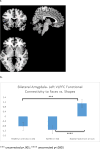Amygdala-prefrontal cortical functional connectivity during implicit emotion processing differentiates youth with bipolar spectrum from youth with externalizing disorders
- PMID: 27756046
- PMCID: PMC5154789
- DOI: 10.1016/j.jad.2016.09.064
Amygdala-prefrontal cortical functional connectivity during implicit emotion processing differentiates youth with bipolar spectrum from youth with externalizing disorders
Abstract
Objective: Both bipolar spectrum disorders (BPSD) and attention deficit hyperactivity disorder (ADHD) present with emotion-regulation deficits, but require different clinical management. We examined how the neurobiological underpinnings of emotion regulation might differentiate youth with BPSD versus ADHD (and healthy controls, HCs), specifically assessing functional connectivity (FxC) of amygdala-prefrontal circuitry during an implicit emotion processing task.
Methods: We scanned a subset of the Longitudinal Assessment of Manic Symptoms (LAMS) sample, a clinically recruited cohort with elevated behavioral and emotional dysregulation, and age/sex-ratio matched HCs. Our sample consisted of 22 youth with BPSD, 30 youth with ADHD/no BPSD, and 26 HCs. We used generalized psychophysiological interaction (gPPI) to calculate group differences to emerging emotional faces vs. morphing shapes in FxC between bilateral amygdala and ventral prefrontal cortex/anterior cingulate cortex.
Results: FxC between amygdala and left ventrolateral prefrontal cortex (VLPFC) in response to emotions vs. shapes differed by group (p=.05): while BPSD showed positive FxC (emotions>shapes), HC and ADHD showed inverse FxC (emotions<shapes). A group x emotion interaction was found in amygdala-subgenual cingulate FxC (p=.025), explained by differences in FxC in response to negative emotions. While BPSD showed positive FxC, HC showed inverse FxC; ADHD were intermediate. Amygdala-subgenual FxC was also positively associated with depressive symptoms and stimulant medication.
Limitations: Co-morbidity and relatively small sample size.
Conclusions: Youth with BPSD showed abnormally positive FxC between amygdala and regions in the ventral prefrontal cortex during emotion processing. In particular, the amygdala-VLPFC finding was specific to BPSD, and not influenced by other diagnoses or medications.
Keywords: Bipolar disorder; Implicit emotion processing; Neuroimaging; fMRI.
Copyright © 2016 Elsevier B.V. All rights reserved.
Figures


References
-
- American Psychiatric Association. Diagnostic and statistical manual of mental disorders. 5th. Author; Washington, DC: 2013.
-
- Axelson D, Birmaher B, Strober M, Gill MK, Valeri S, Chiappetta L, Ryan N, Leonard H, Hunt J, Iyengar S, Bridge J, Keller M. Phenomenology of children and adolescents with bipolar spectrum disorders. Arch Gen Psychiatry. 2006;63:1139–1148. - PubMed
-
- Axelson D, Birmaher BJ, Brent D, Wassick S, Hoover C, Bridge J, Ryan N. A preliminary study of the Kiddie Schedule for Affective Disorders and Schizophrenia for School-Age Children mania rating scale for children and adolescents. Journal of Child and Adolescent Psychopharmacology. 2003;13:463–470. - PubMed
-
- Birmaher B, Brent DA, Chiappetta L, Bridge J, Monga S, Baugher M. Psychometric properties of the Screen for Child Anxiety Related Emotional Disorders (SCARED): a replication study. J Am Acad Child Adolesc Psychiatry. 1999;38:1230–1236. - PubMed
-
- Bowring MA, Kovacs M. Difficulties in diagnosing manic disorders among children and adolescents. J Am Acad Child Adolesc Psychiatry. 1992;31:611–614. - PubMed
Publication types
MeSH terms
Grants and funding
LinkOut - more resources
Full Text Sources
Other Literature Sources
Medical

